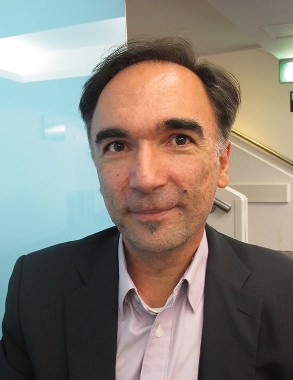User login
SYDNEY, AUSTRALIA – Inspiratory muscle training using a pressure threshold device improved lung cancer patients’ self-reported measures of breathlessness, but did not affect objective measurements of lung function, a pilot trial found.
The study in 46 patients with mostly advanced but stable lung cancer showed statistically and clinically significant differences in ability to cope with breathlessness (P = .02); satisfaction with breathlessness management (P = .024); fatigue (P = .007); emotional function (P = .006); breathlessness mastery (P = .031); anxiety (P = .027); and depression (P = .048).
In the randomized controlled trial, the difference in modified Borg (mBorg) score between the intervention and control groups at 3 months was 0.80, which was borderline clinically significant but not statistically significant. There were no differences in forced expiratory volume in 1 second (FEV1) and forced vital capacity (FVC) levels between the intervention and control groups, according to data presented at a world conference on lung cancer.
Lead investigator Dr. Alex Molasiotis said management of breathlessness in lung cancer is problematic.
"We have very few pharmacological interventions to offer ... so this is one of the fields where we need new evidence, new information, and new interventions," said Dr. Molasiotis, professor and head of the School of Nursing at Hong Kong Polytechnic University.
Inspiratory muscle training has been shown to be effective in some lung diseases such as chronic obstructive pulmonary disease. While the lack of effect on lung function in this pilot study was disappointing, Dr. Molasiotis said the observed improvements in subjective measures were still important.
"Generally we know that FEV1 and FVC don’t really correspond well with subjective measures, and this is something that is clear in the literature," Dr. Molasiotis said in an interview. "[But] it might be that we gave a sense of control to the patients through these techniques; we helped them cope better."
The pressure threshold device increases resistance on inspiration but not on expiration. Patients were instructed to use the device for 30 minutes per day, 5 days a week, for 12 weeks.
While some patients had to break the 30 minutes down into smaller sessions, Dr. Molasiotis said there was unexpectedly high compliance with use of the device.
"This is a population that’s quite ill, but I think it’s also a population that’s quite desperate to have an improvement, so very few of the patients didn’t follow the regime," Dr. Molasiotis said.
The patients were all off first-line treatment to rule out interference from chemotherapy or radiotherapy, and while initially the study investigators set out to recruit nonsmokers only, recruitment difficulties meant they changed the protocol to recruit smokers as well. There were no differences in response between smokers and nonsmokers.
Dr. Molasiotis said inspiratory muscle training is an option that some clinicians might like to consider, but he stressed that it is not appropriate for patients experiencing an acute episode of breathlessness.
The conference was sponsored by the International Association for the Study of Lung Cancer. There were no relevant financial conflicts of interest declared.
SYDNEY, AUSTRALIA – Inspiratory muscle training using a pressure threshold device improved lung cancer patients’ self-reported measures of breathlessness, but did not affect objective measurements of lung function, a pilot trial found.
The study in 46 patients with mostly advanced but stable lung cancer showed statistically and clinically significant differences in ability to cope with breathlessness (P = .02); satisfaction with breathlessness management (P = .024); fatigue (P = .007); emotional function (P = .006); breathlessness mastery (P = .031); anxiety (P = .027); and depression (P = .048).
In the randomized controlled trial, the difference in modified Borg (mBorg) score between the intervention and control groups at 3 months was 0.80, which was borderline clinically significant but not statistically significant. There were no differences in forced expiratory volume in 1 second (FEV1) and forced vital capacity (FVC) levels between the intervention and control groups, according to data presented at a world conference on lung cancer.
Lead investigator Dr. Alex Molasiotis said management of breathlessness in lung cancer is problematic.
"We have very few pharmacological interventions to offer ... so this is one of the fields where we need new evidence, new information, and new interventions," said Dr. Molasiotis, professor and head of the School of Nursing at Hong Kong Polytechnic University.
Inspiratory muscle training has been shown to be effective in some lung diseases such as chronic obstructive pulmonary disease. While the lack of effect on lung function in this pilot study was disappointing, Dr. Molasiotis said the observed improvements in subjective measures were still important.
"Generally we know that FEV1 and FVC don’t really correspond well with subjective measures, and this is something that is clear in the literature," Dr. Molasiotis said in an interview. "[But] it might be that we gave a sense of control to the patients through these techniques; we helped them cope better."
The pressure threshold device increases resistance on inspiration but not on expiration. Patients were instructed to use the device for 30 minutes per day, 5 days a week, for 12 weeks.
While some patients had to break the 30 minutes down into smaller sessions, Dr. Molasiotis said there was unexpectedly high compliance with use of the device.
"This is a population that’s quite ill, but I think it’s also a population that’s quite desperate to have an improvement, so very few of the patients didn’t follow the regime," Dr. Molasiotis said.
The patients were all off first-line treatment to rule out interference from chemotherapy or radiotherapy, and while initially the study investigators set out to recruit nonsmokers only, recruitment difficulties meant they changed the protocol to recruit smokers as well. There were no differences in response between smokers and nonsmokers.
Dr. Molasiotis said inspiratory muscle training is an option that some clinicians might like to consider, but he stressed that it is not appropriate for patients experiencing an acute episode of breathlessness.
The conference was sponsored by the International Association for the Study of Lung Cancer. There were no relevant financial conflicts of interest declared.
SYDNEY, AUSTRALIA – Inspiratory muscle training using a pressure threshold device improved lung cancer patients’ self-reported measures of breathlessness, but did not affect objective measurements of lung function, a pilot trial found.
The study in 46 patients with mostly advanced but stable lung cancer showed statistically and clinically significant differences in ability to cope with breathlessness (P = .02); satisfaction with breathlessness management (P = .024); fatigue (P = .007); emotional function (P = .006); breathlessness mastery (P = .031); anxiety (P = .027); and depression (P = .048).
In the randomized controlled trial, the difference in modified Borg (mBorg) score between the intervention and control groups at 3 months was 0.80, which was borderline clinically significant but not statistically significant. There were no differences in forced expiratory volume in 1 second (FEV1) and forced vital capacity (FVC) levels between the intervention and control groups, according to data presented at a world conference on lung cancer.
Lead investigator Dr. Alex Molasiotis said management of breathlessness in lung cancer is problematic.
"We have very few pharmacological interventions to offer ... so this is one of the fields where we need new evidence, new information, and new interventions," said Dr. Molasiotis, professor and head of the School of Nursing at Hong Kong Polytechnic University.
Inspiratory muscle training has been shown to be effective in some lung diseases such as chronic obstructive pulmonary disease. While the lack of effect on lung function in this pilot study was disappointing, Dr. Molasiotis said the observed improvements in subjective measures were still important.
"Generally we know that FEV1 and FVC don’t really correspond well with subjective measures, and this is something that is clear in the literature," Dr. Molasiotis said in an interview. "[But] it might be that we gave a sense of control to the patients through these techniques; we helped them cope better."
The pressure threshold device increases resistance on inspiration but not on expiration. Patients were instructed to use the device for 30 minutes per day, 5 days a week, for 12 weeks.
While some patients had to break the 30 minutes down into smaller sessions, Dr. Molasiotis said there was unexpectedly high compliance with use of the device.
"This is a population that’s quite ill, but I think it’s also a population that’s quite desperate to have an improvement, so very few of the patients didn’t follow the regime," Dr. Molasiotis said.
The patients were all off first-line treatment to rule out interference from chemotherapy or radiotherapy, and while initially the study investigators set out to recruit nonsmokers only, recruitment difficulties meant they changed the protocol to recruit smokers as well. There were no differences in response between smokers and nonsmokers.
Dr. Molasiotis said inspiratory muscle training is an option that some clinicians might like to consider, but he stressed that it is not appropriate for patients experiencing an acute episode of breathlessness.
The conference was sponsored by the International Association for the Study of Lung Cancer. There were no relevant financial conflicts of interest declared.
AT THE IASLC WORLD CONFERENCE
Major finding: Inspiratory muscle training with a pressure threshold device improved self-reported patient measures of breathlessness and other symptoms such as anxiety and depression, but it did not improve lung function scores.
Data source: Pilot feasibility randomized controlled trial in 46 patients with advanced, stable lung cancer.
Disclosures: There were no relevant financial conflicts of interest declared.

